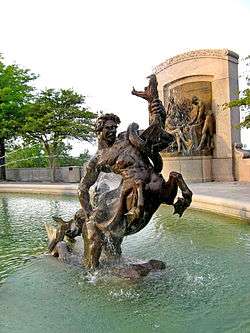Ichthyocentaurs

In late poetical Greek mythology ichthyocentaurs (or ikhthyokentauroi) were a race of centaurine sea-gods with the upper body of a human, the lower front of a horse, the tail of a fish, and lobster-claw horns on their heads. The best-known members of this race were Aphros and Bythos, two half-brothers of the wise centaur Chiron and the sons of the Titan Cronus and Nymph Philyra.
These two sea-gods, though little remembered, were set in the sky as the astronomical constellation Pisces.
The twin ichthyocentaurs appear together in several works of art. A first- or second-century mosaic from Zeugma, Commagene, (Z10.1), depicting the birth of Aphrodite, is inscribed with the names of Bythos ("Sea-Depths" or "Depth of Profundity") and Aphros ("Sea-Foam"), who are lifting the goddess' cockle-shell out of the sea. Aphros was perhaps regarded as her foster-father, given their similarity in names. The two sea-gods also appear in a pair of matching sculptures (belonging to the Louvre and Vatican Museums) depicting them carrying Silen companions of the god Dionysus, after his company was driven into the sea by King Lycurgus of Thrace.
The sea-centaurs were probably derived from the divine fish of Syrian mythology (possibly identified with Dagon[1]) that carried Astarte ashore following her watery birth.
Origin of the name
Ichthyocentaur comes from two different words, ichthyo- and centaur. Ichthyo- comes from the Greek word ikhthis (ιχθύς), which means fish; centaur, or centaurus in Latin, from classical mythology, is a creature having the head, trunk, and arms of a man, and the body and legs of a horse. Ichthyocentaurs have both the attributes coming from the two meanings, which make them a "fish-horse-man". They are related to centaurs, sea nymphs and merfolk; how this came to be is a mystery. It was believed that the creation of these sea-centaurs were depicted as a collection of stars within the constellation Pisces.
Appearance
Ichthyocentaurs upper bodies took the form of a human torso down to the hips, and the lower that of a fish, with two horse legs protruding from this intersection, which is not unlike the appearance of a triton or a merman but with the addition of horse legs in the middle section. Some ichthyocentaurs wore crowns while others were depicted with horns often resembling crustacean claws.
Behavior
These sea-centaurs were thought to be peaceful water-dwelling creatures; they tend to hold great value for their family and friends. Most of the time they are able to get along with other water-dwelling races. Because this type of race is still related to the wild nature of their centaur cousins, some of them still elicit harsh behavior, although not as much as the centaurs. The Ichthyocentaurs tend to roam in milder parties as opposed to more aggressive centaur parties. The ichthyocentaurs' relationship with the nymphs allowed them to live for centuries, having them tend to be aware of many situations in the sea.
Abilities
The Ichthyocentaurs have the ability to both breathe underwater and swim with great speed. They also have more physical stamina than any of the other aquatic races. Other abilities include being able to communicate underwater with several races that live there.
Greek mythology
The two best-known ichthyocentaurs from Greek mythology were Bythos (Sea-Depths) and Aphros (Sea-Foam). Their parents were the Titan Cronus and Nymph Philyra. These two were half-brothers of Chiron the centaur, and were regarded as wise teachers, much like Chiron himself.
Art
Bythos and Aphros appear together in many works of art. One of the more notable ones depict the two sea-gods lifting the goddess Aphrodite's cockle-shell out of the sea after her birth. They also appear together in a pair of matching sculptures, depicting them carrying Seilen companions of the god Dionysus, after his company was driven into the sea by the Thrakian king Lycurgus. Little is known of these two gods, except what can be gathered from their illustrations in art, and a short reference in the Byzantine lexicon of the Suda. Aphros was thought of as the first king of the sea-going Aphroi (Carthaginians), where a mosaic uncovered in Tunisia confirms this belief. It depicts a pair of African sea-gods swimming alongside Poseidon's chariot—one is the ichthyocentaur Aphros, and the other a twin-tailed Triton, god of the Libyan lake Tritonis. Another mosaic art piece depicts Bythos alone carrying the Nereis Thetis along with two other Nereides, Doris and Galateia.
See also
References
- ↑ "Dagon". Catholic Encyclopedia. New Advent. 1995. Retrieved 2010-08-01.
External links
- Theoi Greek Mythology: IKHTHYOKENTAUROI
- Dave's Mythical Creatures and Places: Ichthyocentaur
- University of Pittsburgh: Borges Center: Fantastic Zoology: Ichthyocentaur
- GREEK MYTH INDEX: ICHTHYOCENTAUR
- The Metropolitan Museum of Art: WORKS OF ART: ASIAN ART: Marine Deity (Triton or Ichthyocentaur)
- http://www.goodreads.com/quotes/tag/ichthyocentaur